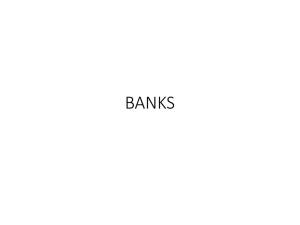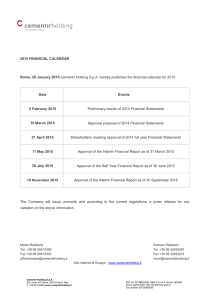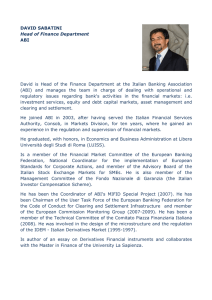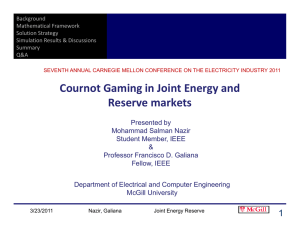What is a central bank?
advertisement
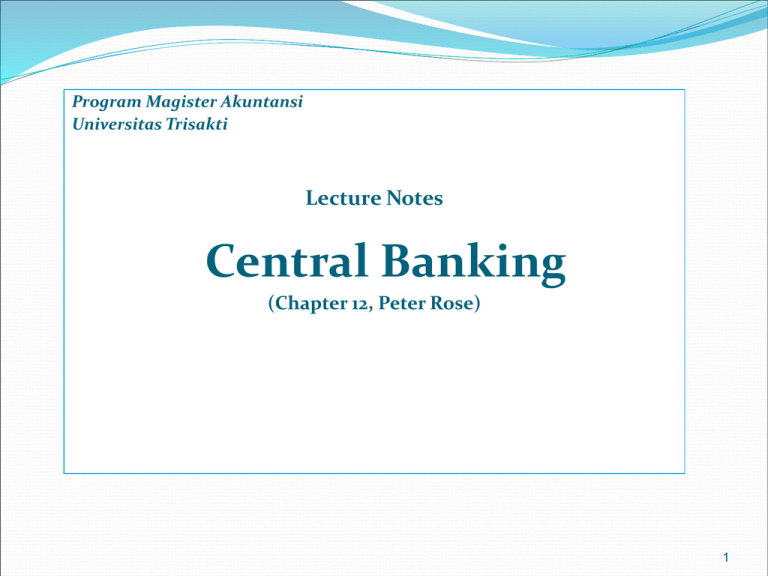
Program Magister Akuntansi Universitas Trisakti Lecture Notes Central Banking (Chapter 12, Peter Rose) 1 What is a central bank? 2 The most important financial institution in a modern economy, it has a strategic role in managing the economy through monetary sector A central bank is a government agency that monitors the operation of its financial system and controls the growth of the nation’s money supply. Central banks are “bankers’ banks.” They communicate with commercial banks and securities dealers in carrying out their essential public policy functions. A public institution, protecting public interests Bank for money circulation Monetary authority 2 Evolution of central bank 3 Peran bank sentral di berbagai negara bermula dari bank sirkulasi dan kemudian mengalami evolusi hingga menjadi bank sentral yang modern dgn tujuan yang lebih fokus dan independen ......... Bank Sirkulasi & Bankers bank Bank Sentral (awal) Bank umum (komersial) yang berfungsi sbg bank sirkulasi (mencetak dan mengedarkan uang) Peran dlm pengendalian moneter, perbankan, dan sistem pembayaran mulai dituntut Juga sbg banker’s bank (lender of last resort). Sebagai bagian dari Pemerintah, termasuk pembiayaan fiskal dan program Pemerintah. Masih berperan ganda sbg bank komersial. Tujuan jamak (inflasi, nilai tukar, pertumbuhan, lapangan kerja, neraca pembayaran) Bank Sentral (dewasa ini) Tujuan tunggal, yaitu stabilitas harga (dan nilai tukar) Fokus pada tiga tugas: pengendalian moneter, pengawasan bank, dan penyelenggara sistem pembayaran. Independen dari Pemerintah dgn suatu mekanisme koordinasi. Tuntutan penguatan akuntabilitas dan transparansi. 3 Evolution of central bank Evolusi peran bank sentral banyak dipengaruhi oleh perkembangan ekonomi dan keuangan, tatanan sosial dan politik, serta pandangan dari sisi teori ekonomi ......... Bank Sentral (dewasa ini) Industrial revolution & merchantilism. Emergence of banking and payment system Perlunya pertumbuhan pasca Perang Dunia. Financial repression & gov’t lead development Bretton wood & Intern’l trade focus Globalization & financial liberalization Cross-border capital flows & crises Pentingnya disiplin dan fokus keb. ekonomi Pandangan Teori Bank Sentral (awal) Classical economic thoughts of Adam Smith, Fisher, Keyness, Ricardo, Casel, etc. on growth, money, prices, interest, exchange rates etc. Macroeconomic (output) stabilization policy. Debat Klasik vs. Keynes Mundell-Fleming utk ekonomi terbuka. Structural adjustment policies (First generation reforms) Colonialism from the West, strugle for and emergence of independence in the East. Neo-classical synthesis: LR money neutrality & SR Phillips curve inflation focus of monetary policy. Rational expectation & Real business cycle transparency, komitmen, credibility Good governance (Second generation reforms) SosialPolitik Ekonomi Keuangan Bank Sirkulasi & Banker’s bank 4 Democratization in the West, but not in the East Nationalism & “catching up” from the East Democratization movements from the West, “spill-over” to the East. 4 The role of central bank in the economy 1. Control of money supply to avoid severe inflation – price stability 2. to maintain Maintain price stability thru (aggregate) demand management by controlling money supply and or interest rates. Price stability is a necessary condition to sustain economic growth Stabilizing financial markets – money and capital markets Fostering development of financial markets Ensuring a stable flow of funds through those markets 3. Lender of the last resort - for financial institutions squeezed by severe liquidity pressures when alternative source of funds have dried up. 4. Supervisor of the banking system 5. Providing and improving payments system - a smoothly functioning and efficient payments mechanism is vital for business and commerce Helping Interbank Clearing and settlement system Money circulation – providing supply of currency and coins 5 Central bank and its functions in several countries Not all central banks have the three functions: 1)monetary authority, 2)banking regulator, and 3) provider of payment services. But every central bank has at least its monetary function. Negara Indonesia Malaysia Selandia Baru Afrika Selatan Brasil India Singapura Belanda Itali Jerman Amerika Perancis Australia Jepang Brunei Hong Kong Inggris Sumber : berbagai referensi Otoritas Moneter Pengatur Bank Sistem Pembayaran Ya Ya Ya Ya Ya Ya Ya Ya Ya Ya Ya Ya Ya Ya Ya Ya Ya Ya Ya Ya Ya Ya Ya Ya Sebagian Sebagian Sebagian Sebagian Sebagian Tidak Tidak Tidak Tidak Tidak Ya Ya Ya Tidak Sebagian Sebagian Sebagian Ya Ya Ya Sebagian Sebagian Ya Ya Tidak Tidak Tidak 6 Channels through which Central Banks work Central banks affect the economy as a whole through managing market interest rates and banks’ reserves which in turn lead to: 1. Changes in the cost of and availability of credit to business, consumers, and government 2. Changes in the volume and rate of growth of the money supply 3. Changes in the financial wealth of investors as reflected in the market value of their stocks, bonds, and other security holdings 4. Changes in the relative prices of domestic and foreign currencies (exchange rates) 5. Changes in the public’s expectations regarding future money and credit conditions and currency values. 7 Channels through which Central Banks work Cost & availability of credit Policy tools of the central bank Market interest rates Size & growth of the money supply Market value of the public’s security holdings Level & growth of reserves in the banking system Currency exchange rates Public expectations regarding security prices, interest rates, currency prices, money supply & credit availability Volume & growth of borrowing & spending by the public on domestic & foreign consumer & capital goods & services Economic goals: •A stable price level and low inflation •Sustainable economic growth •Maximum employment 8 Pioneering central banks 9 Bank of England (the oldest central bank) Bank of England Act 1694 The most recent legislation is the Bank of England Act 1998 which established the arrangements for the Bank’s current monetary policy responsibilities. Under the 1998 Act, the Banking Supervision function that had previously been undertaken by the Bank was transferred to the newly formed Financial Services Authority. The goal is to maintain a stable and efficient monetary and financial framework as its contribution to a healthy economy. There are two core purposes of BOE, which are monetary stability and financial stability. 9 World Leading Central Banks 10 10 World Leading Central Banks 11 The Federal Reserve System On December 23, 1913, the Federal Reserve System, which serves as the nation's central bank, was created by an act of Congress The Federal Reserve’s duties fall into four general areas: - Conducting the nation’s monetary policy by influencing the monetary and credit conditions in the economy in pursuit of maximum employment, stable prices, and moderate long-term interest rates - Supervising and regulating banking institutions to ensure the safety and soundness of the nation’s banking and financial system and to protect the credit rights of consumers - Maintaining the stability of the financial system and containing systemic risk that may arise in financial markets - Providing financial services to depository institutions, the U.S. government, and foreign official institutions, including playing a major role in operating the nation’s payments system 11 The Federal Reserve System Supervise Board of Governors (7 members appointed by the president) 12 Federal Reserve banks & 25 branch banks (reserve bank presidents appointed by Board of Governors) Supervise 3,200 member banks of the system Serve Serve Federal Open Market Committee (12 voting members) Supervise Manager of the System Open Market Account 12 The Federal Reserve System 13 The Federal Reserve System • In principle, the Board of Governors is independent of both legislative and executive branches of the federal government. This independence is supported by terms of office much longer than the president’s (up to 14 years), and by the fact that the Fed is self-supporting. • When the Federal Open Market Committee (FOMC) has reached a consensus on the appropriate future course for monetary policy, a directive is given to the manager of the System Open Market Account (SOMA). • The SOMA manager is a vice president of the Federal Reserve Bank of New York. • Each Reserve bank houses a research division that studies regional economic and financial developments, and reports its findings to the Board of Governors and to the FOMC. • The Reserve banks also provide the securities needed for open market sales, and take their pro rata share of security purchases made by the Federal Reserve System. 14 The Federal Reserve System • The member banks of the Federal Reserve System consist of national banks, which are required to join the system, and state-chartered banks that agree to conform to the Fed’s rules. • At year-end 2000, there are 2,230 national banks and just under 1,000 state-chartered banks registered as members of the Federal Reserve System, compared to more than 5,000 nonmember banks. 15 The role of Federal Reserve System today • Collecting and clearing checks and other means of payment (through an electronic network known as the FEDWIRE) • Issuing currency and coin • Maintaining a sound banking and financial system, by serving as a lender of last resort (through the discount window of each Reserve bank) and by supervising member banks • Serving as the Federal government’s fiscal agent, by holding the Treasury’s checking account and by maintaining reasonable stability in the government securities market • Providing information to the public, through statistical releases and research reports • Carrying out monetary policy, through the use of various tools 16 The Federal Reserve System 17 The Federal Reserve System 18 Central Banking in Indonesia Peran dan kelembagaan bank sentral di Indonesia mengalami evolusi dari bank sirkulasi hingga bank sentral spt dewasa ini ....... 1968-1998 1999 Bentuk formal bank sentral belum ada. De Javasce Bank (DJB) vs BNI. BI sbg bank sentral RI. Bagian dr Pemerintah Peran Dewan Moneter BI sbg bank sentral RI Bagian dr Pemerintah Peran Dewan Moneter UUD 1945 Pasal 23: BI sbg bank sentral UU Nasionalisasi DJB UU No. 11 Th 1953 ttg BI sbg pengganti DJB wet 1922. UU No. 13 Th 1968 ttg Bank Sentral. Peran sbg: (i) Agen Pemb, (ii) Kasir Pem, (ii) Bankers bank Masih menjalankan fungsi bank komersial. Tugas: (i) Stabilitas moneter, (ii)Pengedaran uang, (iii) Sistem pembayaran. Masih berperan sbg: (i) Agen Pemb., (ii) Kasir Pem, (ii) Bankers bank. Fungsi bank komersial tidak ada lagi. Tugas: (i) Stabilitas nilai rupiah, (ii) Mendorong produksi, kesempatan kerja. Pencetakan uang utk defisit fiskal vs. Sanering 1959 dan hyperinflasi 1965/68. Stabilisasi ekon (1968-72) Boom minyak (1973-82) & keb mon langsung (KLBI). Deregulasi (1983-92) dan keb mon tidak langsung. Krisis 1997, BLBI, reformasi. Konflik tujuan stabilitas nilai 19 rupiah vs. tujuan lain Peristiwa Penting Peran Status 1953-1967 Landasan Hukum 1945-1952 19 DJB dan BNI sbg bank sirkulasi. Mata uang Belanda & Jepang vs. ORI. Dominasi politik dan pembiayaan bank sentral. Pencetakan uang vs. Sanering (Gunting Sjafrudin) 1950. Central Banking in Indonesia Established in 1953 as the central bank while functioning commercial banking, taking over the role of de Javasche bank (a commercial bank and the bank for money circulation since 1827) Bank Indonesia’s role Maintaining monetary stability Money circulation Banking supervision and development Commercial banking Monetary Board (a government body) responsible monetary policy, and Bank Indonesia responsible for its implementation Under UU 13/1968, Bank Indonesia was setup as a pure central bank, eliminating its commercial operation but maintaining its role as the agent for national development, cashier for government and bankers’ bank. BI can extend credits to commercial banks (KLBI, BLBI) Conflict between promoting growth/employment and containing inflation 20 Bank Indonesia Peran dan kelembagaan bank sentral di Indonesia dewasa ini menganut prinsip-prinsip bank sentral modern yang juga diterapkan di negara-negara lain ....... 21 Dasar Hukum UU No. 23/1999 tentang Bank Indonesia sebagaimana diamandemen dengan UU No. 3/2004 Tujuh aspek amandemen: (1) Penetapan sasaran inflasi, (2) Pengalihan pengawasan bank, (3) Penyediaan financial safety nets, (4) Mekanisme pencalonan Dewan Gubernur, (5) Penguatan akuntabilitas dan transparansi, (6) Pembentukan Badan Supervisi, (7) Persetujuan anggaran operasional oleh DPR Tujuan Menganut single objective, yaitu menjaga kestabilan nilai rupiah, dalam arti inflasi dan nilai tukar. Dengan sistem nilai tukar mengambang, tujuan diarahkan kepada kestabilan harga (inflasi). Nilai tukar berdasarkan mekanisme pasar. Intervensi BI untuk mencegah gejolak guna kestabilan nilai tukar. Penetapan sasaran inflasi oleh Pemerintah setelah berkoordinasi dengan BI. BI tidak lagi goal independence, tetapi masih instrument independence. Koordinasi kebijakan moneter BI dengan kebijakan fiskal/makro ekonomi Pemerintah semakin diperlukan. 21 Bank Indonesia Tugas Tiga tugas: (1) Pengendalian moneter, (2) Pengawasan bank, (3) penyelenggara/pengatur sistem pembayaran. Pengendalian moneter: Penetapan sasaran-sasaran moneter untuk mencapai sasaran inflasi. Instrumen moneter terutama dengan OPT melalui lelang SBI dan SUN. Sasaran operasional uang primer telah beralih ke sasaran suku bunga sesuai Inflation Targeting. Pengawasan perbankan: Pengaturan dan pengawasan bank untuk menciptakan sistem perbankan yang sehat dan kuat, termasuk percepatan fungsi intermediasi perbankan. Penerapan 25 Basle Core Principles dan Risk Based Supervision. Arsitektur Perbankan Indonesia (API) sbg arah ke depan. Penyelenggaraan sistem pembayaran: Tunai (uang kertas dan logam) dan non-tunai (giral, kliring, dan alat pembayaran lain). Sistem kliring beralih dari manual dan ritel ke elektronik dan Real Time Gross Settlement (RTGS). Amendemen UU BI: Pengalihan pengawasan bank akhir 2010 dan pengaturan financial safety nets. Koordinasi erat dengan Pemerintah: Kebijakan moneter dgn kebijakan fiskal Pemerintah. Peran internasional: Keanggotaan pada IMF dan lembaga internasional lain, manajemen utang luar negeri, dsb. 22 22 Bank Indonesia Kelembagaan 23 Manajemen Bank Indonesia : 1. Kepemimpinan: Dewan Gubernur sebagai pembuat kebijakan. Diusulkan oleh Presiden dan disetujui DPR. Masa jabatan 5 tahun dg akhir masa jabatan berjenjang. 2. Perumusan kebijakan: Dalam Rapat Dewan Gubernur (RDG) secara terjadwal (bulanan dan mingguan). 3. Organisasi: Kantor Pusat (29 Direktorat/Biro), Kantor BI di daerah (37), Kantor Perwakilan di LN (4). 4. Nilai-nilai strategis: Kompetensi, Integritas, Transparansi, Akuntabilitas, dan Kebersamaan. Independensi: (1) Kewenangan penuh dlm melaksanakan tugas yang telah ditetapkan UU (independensi instrumen), dan (2) Larangan campur tangan dari pihak lain (independensi lembaga). Akuntabilitas: Kepada DPR dalam bentuk laporan pelaksanaan tugas (triwulanan dan tahunan) dan penilaian kinerja (tahunan) terhadap institusi dan Dewan Gubernur. Transparansi: Koordinasi dan informasi dg Pemerintah, komunikasi keputusan RDG, publikasi laporan dan kebijakan, kemitraan strategis dan constituent building dg stakeholders, pembelajaran masyarakat. 23 STATUS DAN KEDUDUKAN BI DALAM KETATANEGARAAN RI Menyampaikan laporan keuangan BI yang telah diperiksa Hasil telaah Memeriksa laporan keuangan BI Lembaga Negara (UU No. 23 /1999 UU No.3/2004) PRESIDEN DEWAN PERWAKILAN RAKYAT BADAN PEMERIKSA KEUANGAN Laporan triwulanan/sewaktuwaktu, Tahunan Kepala Kepala PeNegara merintahan UU BI (UUD 45) Pimpinan BI (UU BI) Badan Supervisi Informasi tertulis triwulanan/sewaktuwaktu MAHKAMAH AGUNG Mengambil sumpah dan janji anggota Dewan Gubernur BANK INDONESIA Lembaga Negara dengan Badan Hukum Publik Departemen PUBLIK ( Informasi Tahunan ) 24 24 25 Struktur Organisasi Bank Indonesia Dewan Gubernur Gubernur Deputi Gubernur Senior Deputi2 Gubernur Direktorat Direktorat Direktorat PPSK Direktorat Direktorat Direktorat dst Unit Khusus Biro Kantor Bank Indonesia di daerah Kantor Perwakilan di luar negeri 25 Bank Indonesia’s Balance Sheet (Rp. bio) Assets 1. 2. 3. 4. 5. 6. 7. 8. 9. 10. 11. 12. Gold Foreign currencies SDR Demand deposits Time deposits Marketable securities Claims on government Claims on banks Claims on others Allowance for bad debts Equity participation Other assets Total assets 2005 Liabilities 15,570.2 14.8 68.9 12,283.8 47,260.5 312,626.8 301,472.6 14,197.7 22,030.9 (48,292.6) 820.7 8,609.9 1. 2. 686,664.2 Total liabilities 3. 4. 5. 6. 7. Currency in circulation Demand deposits • Government • Commercial Banks • Int’l Financial inst SBIs Loans from government Foreign borrowings Other liabilities Equity 2005 144,878.6 233,845.3 50,521.0 105,194.4 77,748.2 131,442.5 2,540.6 13,403.3 29,606.5 121,683.4 686,664.2 26
